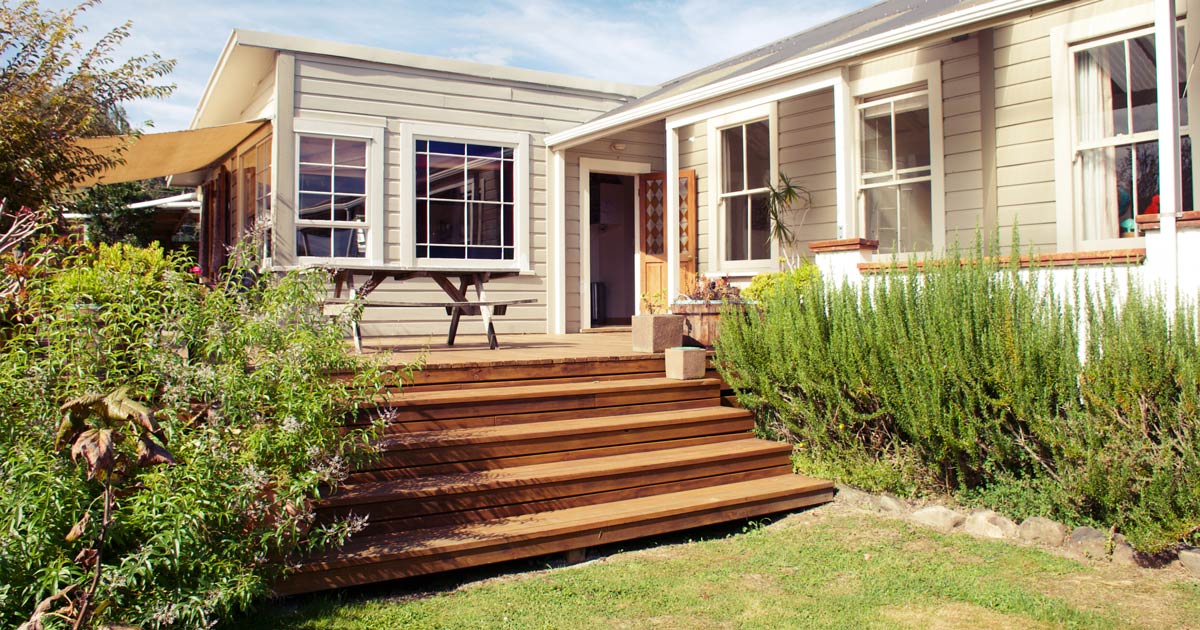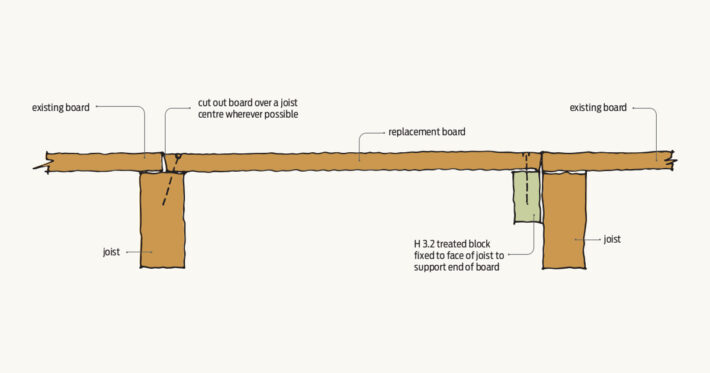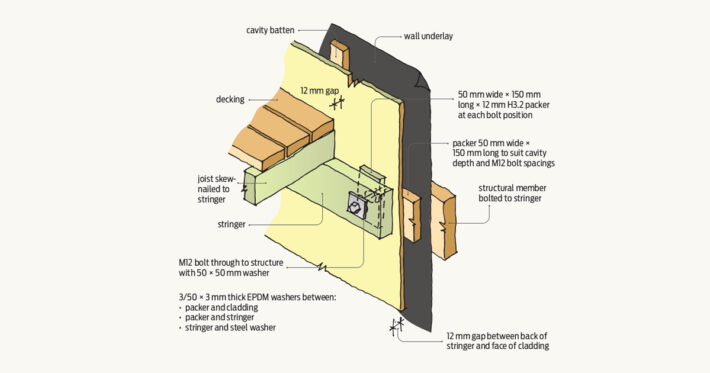Timber decks – problems and repairs
17 Sep 2024, Learn, Prove Your Know How, Technical

Exposed to the elements, aged timber decks frequently need repairs to stay looking good and remain safe to use. Regular maintenance may include replacing rotten boards, fixing nails that have popped, and removing moss and mould
Exposure to weather conditions means that timber decks are particularly vulnerable to deterioration. The repeated wetting and drying, combined with exposure to UV light and temperature changes, causes the boards to continuously swell and shrink and puts a great deal of stress on the timber and fasteners.
Common problems
The most common problems with timber decks are generally due to poor material selection, design and construction or age. Nails pop, boards splinter or become cracked, warped or cupped, fixings corrode and timber rots.
Most problems occur in decks where the timber is unable to dry in between periods of wetting.
These include:
- Decking becoming slippery and stained due to moss or mildew growth
- Decking becoming spongy or springy, sagging, bouncing or developing holes
- Fixings corroding, particularly in coastal environments.
If decks are over 1m above ground, complex or severely deteriorated, seek professional advice first – a specialist may be required to undertake this work safely.
Rot in the timber
Continuously damp timber will rot.
In timber decks, rot occurs most often where moisture is trapped, such as:
- If there is no drainage gap between decking and the wall cladding.
- Where the decking crosses the joists.
- Where the stringer is fixed over the wall cladding to the building with no drainage gap.
- At the base of veranda or balustrade posts.
Rot may also originate in the subfloor framing from where it spreads up into the decking timber.
To test for rot, insert an awl, a knife blade or a screwdriver into the timber. If it slides in easily, the timber is rotten.
Rotten decking timber must be removed either by cutting out the rot and treating the remaining timber with timber preservative or replacing the rotten boards with H3.2 boards (minimum). When replacing rotten decking, the subfloor framing timber should also be checked for rot.
Repairing decks
Repair options for timber decks include:
- Cleaning the deck to remove moss and mildew or staining.
- Making localised, minor repairs such as:
- Refastening nails that have popped or replacing popped nails with screws.
- Refixing boards that are cupped or warped or have become loose.
- Replacing damaged boards.
- Improving deck drainage between decking and wall cladding, decking and joists or wall cladding and stringer.
- Replacing corroded fixings.
- Extensive repair work such as replacing the decking – refer to BRANZ Good Repair Guide Timber decking.
- Repairing damaged subfloor framing – refer to BRANZ Good Repair Guide Subfloor timber.
Cleaning the deck to remove moss and mildew
If using a proprietary deck cleaning solution, follow the manufacturer’s instructions.
Alternatively, remove moss and mildew with a scrubbing brush, detergent and hot water, and
a bleach solution if required, as follows:
- Scrub the boards thoroughly, using detergent and hot water, ensuring that the grooves in the decking and the gaps between the boards are also scrubbed. Rinse off thoroughly and leave to dry.
- If the decking is badly stained, use bleach to clean it. Follow the manufacturer’s instructions for the ratio of bleach to water and check that it will not damage the timber before fully applying. Apply the bleach solution, using a brush or a sponge. Leave for approximately 15 minutes before rinsing off thoroughly and leaving to dry.
When using bleach:
- Wear protective clothing, such as rubber gloves and safety goggles.
- Use an oxygen bleach rather than a chlorine bleach, as oxygen bleach is less harmful
to plants and the environment than chlorine bleach, which is toxic to vegetation, harmful to the environment and corrosive to metal fixings.
Avoid using a high-pressure water spray, such as a water blaster, as the high-pressure water raises the timber fibres, resulting in splinters of timber.
Refastening popped nails
Timber movement due to temperature changes will often cause nails to pop or protrude from the boards.
The nails can be rehammered but this is likely to be a temporary solution, as timber movement will most likely cause the nails to pop again.
Instead, replace the nails with slightly longer and thicker nails that will have a better hold in the timber. The replacements should be annular grooved type 304 stainless steel nails.
Alternatively, replace nails with type 304 stainless steel screws.
Refixing cupped, warped or loose boards
If cupping of boards is shallow, a plane or belt sander can be used to sand down the high edges. Alternatively, depending on the degree of cupping, boards can be turned over and refastened.
If the cupping is significant, boards generally need to be replaced.
Replacing sections of damaged boards
Where there is localised damage
to boards, the damaged sections should be removed and replaced as follows:
- Identify the sections of board requiring removal and mark lines adjacent to or across the centre of joists beyond the extent of the rot or damage. If the timber has rot, make sure that the cutting line is at least 1m beyond the visible rot to ensure that it is completely removed.
- Use a circular or oscillating saw to cut through the decking timber. Cut through each board as required on both marked lines.
- For boards that have been nail-fastened, use a pry bar and a timber block to pry against,
if necessary, to remove the cut section of the decking. Do not pry against undamaged decking. - For boards that have been screw-fastened, remove screws using an electric screwdriver and a screw extractor as required.
- Remove all splintered timber and debris.
- Cut a replacement board (minimum H3.2) to length and fit into the gap, where each section of board has been removed.
- Predrill holes for nails or screws if replacement boards are hardwood.
- Nail or screw-fasten each into place with two fastenings at each end and two fastenings to each intermediate joist.
When cutting directly over the centre of a joist, care must be taken to avoid nails or screws from the original installation. If it is too difficult to remove the section of the board over the joist without damaging the saw, cut the board at the edge of the joist. Nail a block to the side of the joist to provide a nailing surface for the new board to be installed (see Figure 1).

Figure 1: fixing support blocks to joists
Improving deck drainage
Rot to decking timber, joists or wall cladding is likely to be due to poor drainage where components intersect such as between decking and wall cladding, decking and joists or wall cladding and stringer.
Between decking and wall cladding
Improve the drainage between decking and wall cladding, create a gap between the decking and the cladding:
- Remove the decking board closest to the wall cladding and cut a minimum 12mm piece off the edge of the board.
- Replace the board, leaving a 12mm gap between the edge of the board and the cladding.
- If the existing board cannot be reused, replace it with a matching decking timber (minimum H3.2), leaving a 12mm gap between the edge of the board and the cladding.
Between decking and joists
Insufficient drainage between the decking timber and the top of the joists may be because the decking timbers do not have enough gap between adjacent boards, restricting free drainage.
The only way to fix this problem is to remove and replace the decking timbers. Reinstall the reused or new decking boards, allowing a 3-6mm gap between boards for drainage.
Between wall cladding and stringer
If there is rot in either the cladding and/or the stringer where they abut, there may be no gap to allow water to drain away. Create a gap between the cladding and the stringer:
- Install a temporary bearer under the floor joists close to the stringer and supported with hydraulic jacks. The temporary bearer should be at least the same depth as the stringer.
- Slowly jack up the temporary bearer by raising each jack approximately 5mm in turn until the bearer has been raised enough to remove the load from the stringer and provide access to cut through joist fastenings.
- Cut through nails fixing joists to the stringer using a hacksaw.
- Unfasten the bolts attaching the stringer to the wall and remove the stringer.
- If there is rot in the weatherboards, the affected boards will need to be replaced – refer to BRANZ Good Repair Guide Horizontal timber weatherboards.
- Insert H3.2 treated, 150 × 12mm thick packers (or UV-resistant 12mm plastic washers) with holes the same diameter as the bolt fixings at each bolt fixing.
- If the stringer can be reused, re-bolt the stringer to the wall over the packers.
- If the stringer cannot be reused, fix a new stringer to the wall over the packers. The stringer should be H3.2 treated timber and either 190 × 45mm or 140 × 45mm depending on joist spans and bolt spacings. See NZS 3604:2011 Timber-framed buildings section 6.13.
- Refasten the joists to the stringer.
- Remove the jacks and temporary beam. (See Figure 2).

Figure 2: connection of deck stringer to cladding – cavity
Replacing corroded fixings
Fixings that have corroded lose strength and should be replaced.
Corrosion may also cause staining of timber around the nails. While this is not a structural problem, if visually unacceptable, the staining can only be removed by replacing boards.
Extensive repair work such as deck replacement
If decking timber is in poor condition generally, the best solution may be to remove and replace it. Grooved or ridged decking timber should be laid with the grooved side down so that air can circulate where the boards are in contact with the joists.
This article was first published in BRANZ’s Build 188 magazine. www.buildmagazine.co.nz. Words supplied by BRANZ.
Register to earn LBP Points Sign in
3 Comments
Leave a Reply
You must be logged in to post a comment.




Awesome
Helpful
great